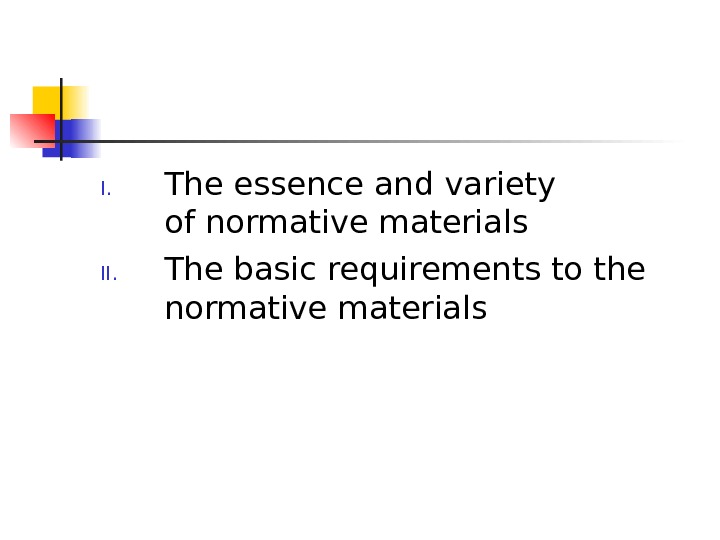NORMATIVEMATERIAL S I. The essence andvariety ofnormativematerials









9.normative_materials.ppt
- Размер: 78.5 Кб
- Количество слайдов: 8
Описание презентации NORMATIVEMATERIAL S I. The essence andvariety ofnormativematerials по слайдам
 NORMATIVEMATERIAL S
NORMATIVEMATERIAL S
 I. The essence andvariety ofnormativematerials II. The basicrequirements tothe normative materials
I. The essence andvariety ofnormativematerials II. The basicrequirements tothe normative materials
 I. The essence andvariety ofnormativematerials Normativematerials for the labor normalization is a regulated value s of operation modesof equipment andlabor expenditure, time for breaks in work, designedaccording to differentproduction factors and intendedfor repeated use while establishing thespecific normsof labor expenditure s in relationto specificorganizational andtechnical conditions. Normativematerialsdeveloped on the basis of complex researchescarried out on a leading enterprises, and consequentlytheir introductionat other enterprisesensures the distribution ofmore advancedorganizational and technical conditionsof production.
I. The essence andvariety ofnormativematerials Normativematerials for the labor normalization is a regulated value s of operation modesof equipment andlabor expenditure, time for breaks in work, designedaccording to differentproduction factors and intendedfor repeated use while establishing thespecific normsof labor expenditure s in relationto specificorganizational andtechnical conditions. Normativematerialsdeveloped on the basis of complex researchescarried out on a leading enterprises, and consequentlytheir introductionat other enterprisesensures the distribution ofmore advancedorganizational and technical conditionsof production.
 According to the centrallydevelopedstandardstechnically valid norms are calculated. Theyare the basis forimplementation of the mostproductivemodes of operation of the equipment, improv e theorganizational and technical conditionsof production andlabor processes. Application ofstandards for the labor normalizationensures the unityoflabornormsfor similarworks performed bydifferentdepartments(sections) of the enterprise. In addition, establishment of norms , based on existingstandardssignificantly reduces the volume of workon labor normalization.
According to the centrallydevelopedstandardstechnically valid norms are calculated. Theyare the basis forimplementation of the mostproductivemodes of operation of the equipment, improv e theorganizational and technical conditionsof production andlabor processes. Application ofstandards for the labor normalizationensures the unityoflabornormsfor similarworks performed bydifferentdepartments(sections) of the enterprise. In addition, establishment of norms , based on existingstandardssignificantly reduces the volume of workon labor normalization.
 Classification of normativematerials 1. According to the degreeof differentiation : Differentiated standards : microelement ( provide a time to perform a separatemovements orcomplex ofmovements ); element ( provide a regulatedvaluesto perform a techniquesorcomplex of techniques ); Enlarged standards ( regulate a time for execution a complexes of techniques, and is applied to calculatenorms in termsof serialandsingle production. Their useacceleratesthe calculationof norms andreduces the risk ofmistakesin calculations, but at thesame time , reduces the accuracy ofnorms in comparisonwith the differentiatedstandards )
Classification of normativematerials 1. According to the degreeof differentiation : Differentiated standards : microelement ( provide a time to perform a separatemovements orcomplex ofmovements ); element ( provide a regulatedvaluesto perform a techniquesorcomplex of techniques ); Enlarged standards ( regulate a time for execution a complexes of techniques, and is applied to calculatenorms in termsof serialandsingle production. Their useacceleratesthe calculationof norms andreduces the risk ofmistakesin calculations, but at thesame time , reduces the accuracy ofnorms in comparisonwith the differentiatedstandards )
 2. According to the scope of application : Intersectoral ( intended forlabornormalizationof typicalworks executedat enterprisesof different industries ); Sectoral ( have a morenarrow directionand are intended for a normalizationof worksthat are specific for a particular industry. While their development, researches at companies of the same industry are carried out , so these standards reflect thetypicalworks for the industry, organizational and technicalconditions of theirimplementation ); Local ( developeddirectly within enterprisesto thosekinds ofworks whichare specific tothe company andare not included in the intersectoraland sectoral standards )
2. According to the scope of application : Intersectoral ( intended forlabornormalizationof typicalworks executedat enterprisesof different industries ); Sectoral ( have a morenarrow directionand are intended for a normalizationof worksthat are specific for a particular industry. While their development, researches at companies of the same industry are carried out , so these standards reflect thetypicalworks for the industry, organizational and technicalconditions of theirimplementation ); Local ( developeddirectly within enterprisesto thosekinds ofworks whichare specific tothe company andare not included in the intersectoraland sectoral standards )
 3. According to the appointment : Standards of operation modesof the equipment ( regulated parameters of the equipment work to ensureits most effectiveuse. They are usedto calculatethe length ofthe main (technological) time ); Standards of time; Standardsof labor service ; Standards of number of employees.
3. According to the appointment : Standards of operation modesof the equipment ( regulated parameters of the equipment work to ensureits most effectiveuse. They are usedto calculatethe length ofthe main (technological) time ); Standards of time; Standardsof labor service ; Standards of number of employees.
 II. The basicrequirements tothe normative materials : be progressive ; be comprehensive andreasonable ; be accurate ; more fullycover themost commonvariantsof organizational and technicalconditions ofthe work ; be comfortableto use ; be regularly reviewed.
II. The basicrequirements tothe normative materials : be progressive ; be comprehensive andreasonable ; be accurate ; more fullycover themost commonvariantsof organizational and technicalconditions ofthe work ; be comfortableto use ; be regularly reviewed.

